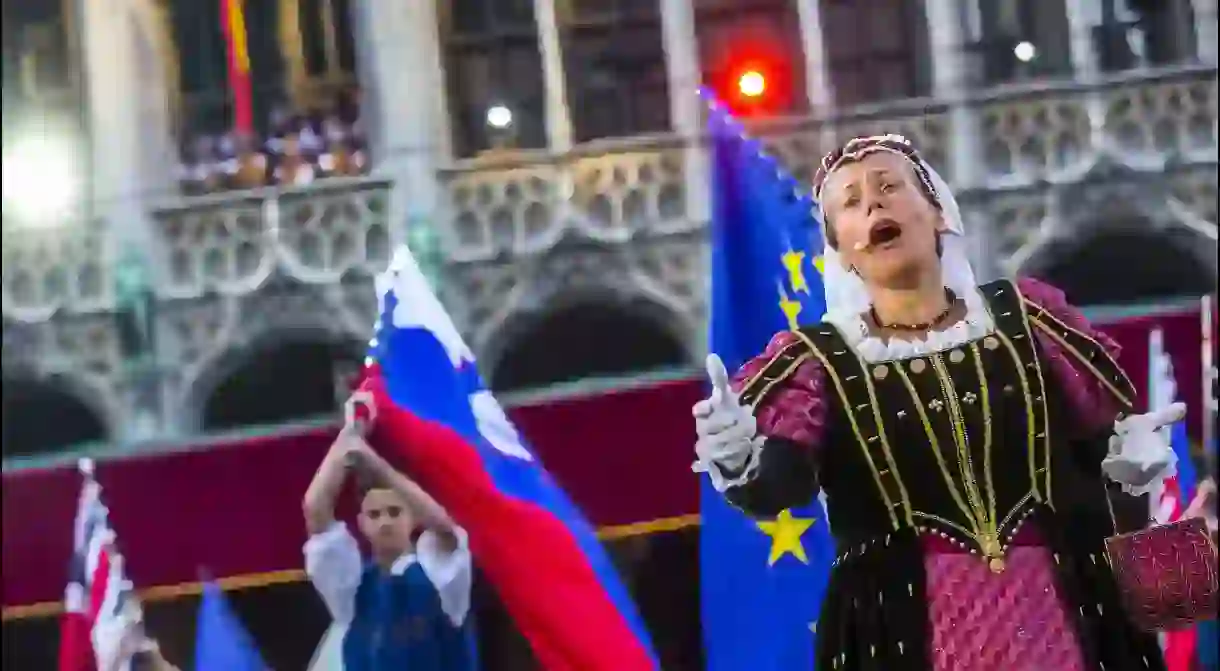An Introduction to Belgian Traditional Dress

Relegated nowadays to special occasions such as the Binche Carnival and Brussels’s age-old Ommegang parade, Belgium’s traditional costumes range from elaborate, plumy constructions meant to stand out in a crowd to quaint farmer’s wear with perhaps a bonnet thrown in. Divided as the country is between Dutch-speaking Flanders, French-speaking Wallonia and the smaller German-speaking communities, each region had its own neighboring country to turn to for inspiration and influence.
The most famed and extravagant among Belgian costumes belongs to the “Gilles,” curiously masked figures who fill the streets of the Walloon town of Binche on Mardi Gras. In the afternoon, they pelt oranges at an excited crowd, but not before everyone has had a chance to awe at their vibrant, yellow-and-orange-striped costumes, packed with straw and with patches of crowns and lions sewn on for a larger-than-life look. At different points in the procession, the Gilles will don either wax masks, symbolic of a bourgeois gentleman during the time of Napoleon III, or sky-high ostrich feather hats, strikingly white in contrast to the rest of the costume. Though the Gilles are clearly the showstoppers, three other groups in medieval outfits—the pierrots, harlequins, and peasants—join them. With the whole town deeply invested in the 14th-century tradition, and life as a Gilles considered a badge of honor in the community, these ancient costumes are likely to be around for a while.

Whereas Gilles-hood is solely a male occupation, another showy Belgian outfit that has persisted throughout the centuries is the “huntress,” an elaborate dress usually made for medieval ladies of means. This most classic of gowns had large, flaring sleeves as its most striking feature, often embroidered around the edges with decorative Celtic trimming. The attractive way it flows still compels some brides to select it as their dress for a folkloric-themed wedding these days, and it wouldn’t be uncommon for such a happening to feature bridesmaids wearing eponins. The latter, especially feminine thanks to its slimming waist and square neckline, was another very popular dress among women of all sizes. These and other, particularly lush and brocaded 16th-century costumes can be admired during Brussels’s Ommegang parade when 1,400 decked-out extras reenact the resplendent procession hosted for Emperor Charles V and his son Philip II’s arrival in Brussels in 1549. Visitors to Belgium can spot other medieval outfits during Ypres’ triennial Cat Festival.

As for the general populace, smocks and berets were the preferred fashion among men until suits came into play in the 19th century. Before Belgium claimed its independence in 1830, tastes were mostly governed by the French occupiers. Boys in tunics with pantalettes underneath were a regular sight until well into the 19th century, and all young kids, including boys, wore dresses until the 20th century. Over in rural Flanders, black dresses with white aprons over them signaled a certain Dutch influence, but last century, the farmer’s wives of the Kempen, part of the Antwerp province, were dressing mainly in wide skirts and white caps. A large shawl almost resembling a blanket was often thrown over the shoulders, adding an extra matronly touch.














